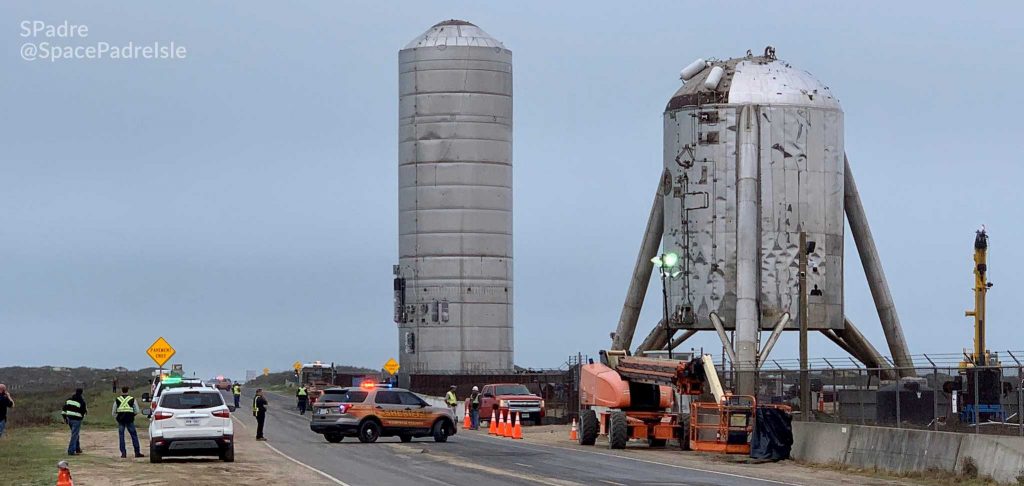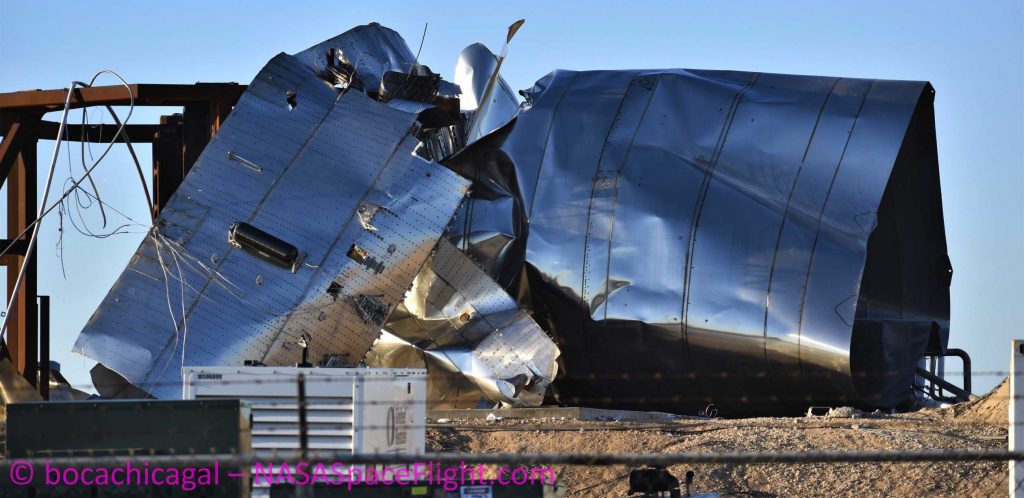News
SpaceX Starship rocket rolls to launch pad to prepare for Starhopper-style hop test
SpaceX has finished its third full-scale Starship prototype and rolled the rocket’s tank and engine section to a nearby launch pad just a matter of weeks after work began, now ready to prepare for a potentially imminent Starhopper-style hop test.
SpaceX’s rapidly-growing Boca Chica, Texas Starship factory is now producing so much rocket hardware that it’s hard to track any single vehicle’s birth. However, it still appears that SpaceX’s Texas team managed to complete the Starship SN3 prototype in less than a month, measured from first steel ring stacking to the ship’s integrated business end being transported to the launch pad. Simultaneously, the company fabricated, assembled, and tested an entirely separate Starship test tank, verifying that a design flaw that likely lead to Starship SN1’s February 28th destruction had been rectified.
Featuring the same design improvements that allowed that Starship test tank to become the first to pass proof testing intact, Starship SN3 is the best candidate yet to kick off true wet dress rehearsal (WDR) and Raptor engine static fire testing. Both will require real liquid methane and oxygen propellant to be loaded, potentially turning Starship SN3 into the equivalent of many tons of TNT if things were to go south. To be clear, there is a significant chance that such an early, rapidly-built prototype will not survive its upcoming test campaign. Nevertheless, Starship SN3 has the numerous lessons learned from both the successes and failures of all previous vehicles built into it, giving it the best chance yet. Still, the massive rocket will need to pass one or several less risky tests before it can begin to attempt more groundbreaking feats.
Set to follow in the footsteps of all previous Starship test articles, SpaceX will soon kick off Starship SN3’s test campaign with a liquid nitrogen proof test – still extremely cold (i.e. cryogenic) but chemically neutral (i.e. can’t explode). Delivery trucks were spotted topping off SpaceX’s liquid nitrogen supplies just yesterday. The company also has a four-hour road closure scheduled to start at 5pm CDT (22:00 UTC) today, shortly after this article went live.



If it isn’t delayed, that March 29th road closure is likely meant to allow SpaceX to pressurize Starship SN3 with liquid nitrogen, pushing it beyond flight pressures (6 bar/90 psi) in what’s known as a proof test. If successful, it would verify that the rocket’s tank section is sound while also bringing it to cryogenic temperatures, potentially strengthening the steel with cryogenic hardening.

Beyond those initial plans, the FAA license SpaceX used to support Starhopper’s July and August 2019 hop tests may actually enable test flights of full-scale Starship prototypes, too. Incredibly, according to Cameron County, Texas beach closure requests made on March 23rd, SpaceX’s goal is to prepare Starship SN3 for a Raptor engine static fire test as early as April 1st (no fool), followed by a potential 150m (500 ft) Starhopper-style flight test on April 6th.
For obvious reasons, delays to that ambitious schedule – particularly the flight test – are extremely likely, but Starship SN3 is now unequivocally at the launch pad. Stay tuned for updates on the rocket’s potentially imminent proof test and the impacts that might have on future tests.

Elon Musk
Elon Musk and Tesla AI Director share insights after empty driver seat Robotaxi rides
The executives’ unoccupied tests hint at the rapid progress of Tesla’s unsupervised Robotaxi efforts.

Tesla CEO Elon Musk and AI Director Ashok Elluswamy celebrated Christmas Eve by sharing personal experiences with Robotaxi vehicles that had no safety monitor or occupant in the driver’s seat. Musk described the system’s “perfect driving” around Austin, while Elluswamy posted video from the back seat, calling it “an amazing experience.”
The executives’ unoccupied tests hint at the rapid progress of Tesla’s unsupervised Robotaxi efforts.
Elon and Ashok’s firsthand Robotaxi insights
Prior to Musk and the Tesla AI Director’s posts, sightings of unmanned Teslas navigating public roads were widely shared on social media. One such vehicle was spotted in Austin, Texas, which Elon Musk acknowleged by stating that “Testing is underway with no occupants in the car.”
Based on his Christmas Eve post, Musk seemed to have tested an unmanned Tesla himself. “A Tesla with no safety monitor in the car and me sitting in the passenger seat took me all around Austin on Sunday with perfect driving,” Musk wrote in his post.
Elluswamy responded with a 2-minute video showing himself in the rear of an unmanned Tesla. The video featured the vehicle’s empty front seats, as well as its smooth handling through real-world traffic. He captioned his video with the words, “It’s an amazing experience!”
Towards Unsupervised operations
During an xAI Hackathon earlier this month, Elon Musk mentioned that Tesla owed be removing Safety Monitors from its Robotaxis in Austin in just three weeks. “Unsupervised is pretty much solved at this point. So there will be Tesla Robotaxis operating in Austin with no one in them. Not even anyone in the passenger seat in about three weeks,” he said. Musk echoed similar estimates at the 2025 Annual Shareholder Meeting and the Q3 2025 earnings call.
Considering the insights that were posted Musk and Elluswamy, it does appear that Tesla is working hard towards operating its Robotaxis with no safety monitors. This is quite impressive considering that the service was launched just earlier this year.
Elon Musk
Starlink passes 9 million active customers just weeks after hitting 8 million
The milestone highlights the accelerating growth of Starlink, which has now been adding over 20,000 new users per day.

SpaceX’s Starlink satellite internet service has continued its rapid global expansion, surpassing 9 million active customers just weeks after crossing the 8 million mark.
The milestone highlights the accelerating growth of Starlink, which has now been adding over 20,000 new users per day.
9 million customers
In a post on X, SpaceX stated that Starlink now serves over 9 million active users across 155 countries, territories, and markets. The company reached 8 million customers in early November, meaning it added roughly 1 million subscribers in under seven weeks, or about 21,275 new users on average per day.
“Starlink is connecting more than 9M active customers with high-speed internet across 155 countries, territories, and many other markets,” Starlink wrote in a post on its official X account. SpaceX President Gwynne Shotwell also celebrated the milestone on X. “A huge thank you to all of our customers and congrats to the Starlink team for such an incredible product,” she wrote.
That growth rate reflects both rising demand for broadband in underserved regions and Starlink’s expanding satellite constellation, which now includes more than 9,000 low-Earth-orbit satellites designed to deliver high-speed, low-latency internet worldwide.
Starlink’s momentum
Starlink’s momentum has been building up. SpaceX reported 4.6 million Starlink customers in December 2024, followed by 7 million by August 2025, and 8 million customers in November. Independent data also suggests Starlink usage is rising sharply, with Cloudflare reporting that global web traffic from Starlink users more than doubled in 2025, as noted in an Insider report.
Starlink’s momentum is increasingly tied to SpaceX’s broader financial outlook. Elon Musk has said the satellite network is “by far” the company’s largest revenue driver, and reports suggest SpaceX may be positioning itself for an initial public offering as soon as next year, with valuations estimated as high as $1.5 trillion. Musk has also suggested in the past that Starlink could have its own IPO in the future.
News
NVIDIA Director of Robotics: Tesla FSD v14 is the first AI to pass the “Physical Turing Test”
After testing FSD v14, Fan stated that his experience with FSD felt magical at first, but it soon started to feel like a routine.

NVIDIA Director of Robotics Jim Fan has praised Tesla’s Full Self-Driving (Supervised) v14 as the first AI to pass what he described as a “Physical Turing Test.”
After testing FSD v14, Fan stated that his experience with FSD felt magical at first, but it soon started to feel like a routine. And just like smartphones today, removing it now would “actively hurt.”
Jim Fan’s hands-on FSD v14 impressions
Fan, a leading researcher in embodied AI who is currently solving Physical AI at NVIDIA and spearheading the company’s Project GR00T initiative, noted that he actually was late to the Tesla game. He was, however, one of the first to try out FSD v14.
“I was very late to own a Tesla but among the earliest to try out FSD v14. It’s perhaps the first time I experience an AI that passes the Physical Turing Test: after a long day at work, you press a button, lay back, and couldn’t tell if a neural net or a human drove you home,” Fan wrote in a post on X.
Fan added: “Despite knowing exactly how robot learning works, I still find it magical watching the steering wheel turn by itself. First it feels surreal, next it becomes routine. Then, like the smartphone, taking it away actively hurts. This is how humanity gets rewired and glued to god-like technologies.”
The Physical Turing Test
The original Turing Test was conceived by Alan Turing in 1950, and it was aimed at determining if a machine could exhibit behavior that is equivalent to or indistinguishable from a human. By focusing on text-based conversations, the original Turing Test set a high bar for natural language processing and machine learning.
This test has been passed by today’s large language models. However, the capability to converse in a humanlike manner is a completely different challenge from performing real-world problem-solving or physical interactions. Thus, Fan introduced the Physical Turing Test, which challenges AI systems to demonstrate intelligence through physical actions.
Based on Fan’s comments, Tesla has demonstrated these intelligent physical actions with FSD v14. Elon Musk agreed with the NVIDIA executive, stating in a post on X that with FSD v14, “you can sense the sentience maturing.” Musk also praised Tesla AI, calling it the best “real-world AI” today.








